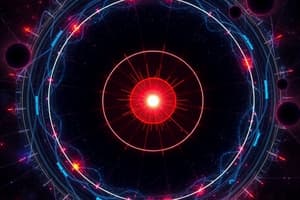Podcast
Questions and Answers
How does a line spectrum differ from a continuous spectrum?
How does a line spectrum differ from a continuous spectrum?
- A line spectrum is produced by reflection, while a continuous spectrum is produced by refraction.
- A line spectrum contains a complete array of colors, while a continuous spectrum contains only a few scattered lines of color.
- A line spectrum contains only a few scattered lines of color, while a continuous spectrum contains a complete array of colors. (correct)
- A line spectrum is associated with molecules, while a continuous spectrum is associated with individual atoms.
What is the significance of the constant 'J' and the quantum number 'n' in the equation $E = -J/n^2$ regarding the Bohr model?
What is the significance of the constant 'J' and the quantum number 'n' in the equation $E = -J/n^2$ regarding the Bohr model?
- 'J' is a constant related to the energy scale of the atom, and 'n' is the quantum number corresponding to the energy level. (correct)
- 'J' represents the mass of the electron, and 'n' represents the number of neutrons in the nucleus.
- 'J' represents the angular momentum of the electron, and 'n' represents the number of protons in the nucleus.
- 'J' represents the ionization energy of the atom, and 'n' represents the number of electrons in the atom.
According to Bohr's model, what happens to an electron when it absorbs energy?
According to Bohr's model, what happens to an electron when it absorbs energy?
- It transitions to a higher energy orbit. (correct)
- It remains in its original orbit but increases its velocity.
- It causes the atom to lose a proton, changing the element identity.
- It jumps to a lower energy orbit, releasing a photon.
How does the concept of 'quantized' relate to the energy levels in the Bohr model of the atom?
How does the concept of 'quantized' relate to the energy levels in the Bohr model of the atom?
What distinguishes the 'ground state' of an atom from its 'excited states'?
What distinguishes the 'ground state' of an atom from its 'excited states'?
In the context of atomic structure, what was the primary contradiction in the planetary model of the atom that led to the development of the Bohr model?
In the context of atomic structure, what was the primary contradiction in the planetary model of the atom that led to the development of the Bohr model?
What contribution did Robert Bunsen and Gustav Kirchhoff make to the study of atomic structure?
What contribution did Robert Bunsen and Gustav Kirchhoff make to the study of atomic structure?
If an electron transitions from $n = 3$ to $n = 1$ in a hydrogen atom, will this result in absorption or emission of energy, and why?
If an electron transitions from $n = 3$ to $n = 1$ in a hydrogen atom, will this result in absorption or emission of energy, and why?
How do spectroscopes and spectrographs aid in the study of light and matter?
How do spectroscopes and spectrographs aid in the study of light and matter?
According to the equation $E=-J/n^2$, how does increasing the value of the quantum number n affect the energy (E) of an electron in the Bohr model, and what does this imply about the electron's position?
According to the equation $E=-J/n^2$, how does increasing the value of the quantum number n affect the energy (E) of an electron in the Bohr model, and what does this imply about the electron's position?
Why are both absorption and emission of energy by electrons described as 'quantized'?
Why are both absorption and emission of energy by electrons described as 'quantized'?
J.J. Thomson and Ernest Rutherford contributed significantly to our understanding of atomic structure. How did their models differ fundamentally from the later Bohr model?
J.J. Thomson and Ernest Rutherford contributed significantly to our understanding of atomic structure. How did their models differ fundamentally from the later Bohr model?
In what fundamental way does the line spectrum of an element support the concept of quantized energy levels in atoms?
In what fundamental way does the line spectrum of an element support the concept of quantized energy levels in atoms?
Consider a hypothetical atom with energy levels defined by $E_n = -C/n^3$, where C is a constant. If an electron transitions from $n = 2$ to $n = 1$, how would the energy of the emitted photon compare to that of a hydrogen atom transitioning from $n = 2$ to $n = 1$?
Consider a hypothetical atom with energy levels defined by $E_n = -C/n^3$, where C is a constant. If an electron transitions from $n = 2$ to $n = 1$, how would the energy of the emitted photon compare to that of a hydrogen atom transitioning from $n = 2$ to $n = 1$?
An astronomer observes the spectrum of a distant star and notices that the absorption lines for hydrogen are shifted towards the red end of the spectrum compared to their known positions in a laboratory. What can they infer from this observation?
An astronomer observes the spectrum of a distant star and notices that the absorption lines for hydrogen are shifted towards the red end of the spectrum compared to their known positions in a laboratory. What can they infer from this observation?
Two different elements, X and Y, have distinctly different line spectra. What does this indicate about the atoms of these elements?
Two different elements, X and Y, have distinctly different line spectra. What does this indicate about the atoms of these elements?
In what way did Niels Bohr's model build upon the prior work of Rutherford, and what key limitation of Rutherford's model did Bohr address?
In what way did Niels Bohr's model build upon the prior work of Rutherford, and what key limitation of Rutherford's model did Bohr address?
Consider two hydrogen atoms: one in its ground state and another in an excited state with $n = 3$. How does the radius of the electron's orbit in the excited atom compare to that of the ground state atom, according to the Bohr model?
Consider two hydrogen atoms: one in its ground state and another in an excited state with $n = 3$. How does the radius of the electron's orbit in the excited atom compare to that of the ground state atom, according to the Bohr model?
Suppose a new element is discovered and its spectrum shows a unique set of lines not matching any known element. According to the principles learned from Bunsen and Kirchhoff's work, what can be definitively concluded?
Suppose a new element is discovered and its spectrum shows a unique set of lines not matching any known element. According to the principles learned from Bunsen and Kirchhoff's work, what can be definitively concluded?
Imagine an electron absorbs a photon with precisely the energy difference between the $n=2$ and $n=4$ energy levels in a hydrogen atom. What will happen to this electron according to the Bohr model?
Imagine an electron absorbs a photon with precisely the energy difference between the $n=2$ and $n=4$ energy levels in a hydrogen atom. What will happen to this electron according to the Bohr model?
Flashcards
Spectroscope and Spectrograph
Spectroscope and Spectrograph
Instruments used to separate colors of light and measure their frequencies.
Line Spectrum
Line Spectrum
A spectrum that contains only a few discrete lines of color against dark background.
Continuous Spectrum
Continuous Spectrum
A spectrum containing the complete array of colors, like a rainbow.
Planetary Model
Planetary Model
Signup and view all the flashcards
Energy Levels
Energy Levels
Signup and view all the flashcards
Quantized
Quantized
Signup and view all the flashcards
Ground State
Ground State
Signup and view all the flashcards
Excited State
Excited State
Signup and view all the flashcards
Study Notes
Atomic Spectra
- Spectroscopes and spectrographs separate colors and measure frequencies in a lab.
Line Spectra
- Robert Bunsen and Gustav Kirchhoff studied line spectra.
- Line spectrum: Contains only a few scattered lines of color.
- Continuous spectrum: Contains the complete array of colors.
Contradictions in the Planetary Model
- JJ Thomson and Ernest Rutherford developed the planetary model.
- The planetary model portrays the atom as a miniature solar system.
The Bohr Model of the Atom
- Niels Bohr proposed that electrons in hydrogen atoms can only move around the nucleus in specific orbits.
- Energy levels are specific orbits around the nucleus where electrons can move.
- Quantized means restricted to certain values.
- $$E=-J/n^2$$ is an equation.
- J is a constant; n is the quantum number.
- Ground state: The lowest energy state of an atom (n=1), which is the most stable.
- Excited states: All energy states other than the ground state.
- Both absorptions and emissions are quantized.
Studying That Suits You
Use AI to generate personalized quizzes and flashcards to suit your learning preferences.




